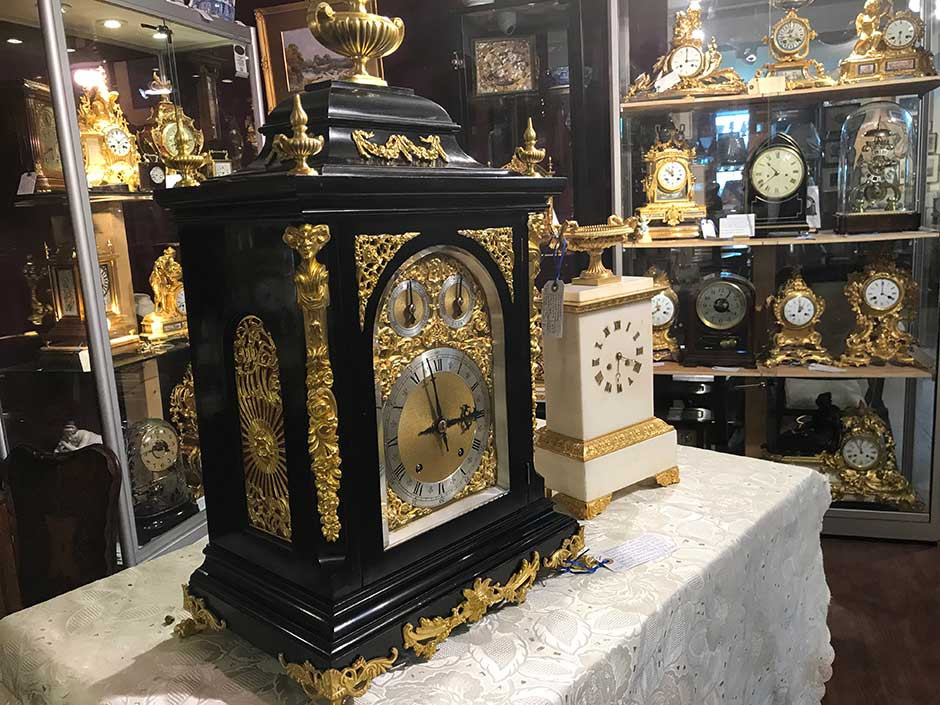
Antique clocks have more depth than most antiques. Not only do they show off the expertise of the clockmaker, but also the talents of the cabinet-maker, the polisher, the engraver, the brass caster… right the way down to the painter of the dials. Here at Hemswell Antiques, we appreciate them as we would do a work of art - analysing every intricate layer of history that’s gone into the mechanically beautiful designs. We pride ourselves on our range of antique clocks for sale: from longcase to bracket, cuckoo to carriage, there are many different types to pique the interests of collectors or dealers. Here’s what to consider before you browse:
Different types of antique clocks
Once the most sophisticated machines in the world, the age and authenticity of antique clocks can be determined by the knowledge each piece showcases. The first mechanical weight-driven clocks were used in European churches around 1280, before being scaled down into smaller versions for household use in the late 14th century. In the 15th century, coiled springs were applied to clocks, which eventually led to watches. If you’re looking to invest in antique clocks, these are the main pieces to look out for:
- Antique wall clocks
The early 18th century saw the adornment of big wall-hung clocks in taverns, inns, assembly rooms and other public buildings. They were designed to be read from a distance, with gilt numerals and wooden dials often in a shield-shaped design. By the late 18th century, lacquered tavern cases were eschewed for mahogany, followed by dial clocks in oak, walnut and rosewood crafted for offices, shops and railway stations. Watch out for antique clocks with extensive repainting, although some may show signs of this on the numerals, chapter ring or signature.
Collectors tip: One name to look out for is Gustav Becker: a 19th-century clockmaker who rose to popularity in 1875, when he sold around 300,000 clocks annually. Vienna wall clocks from this time and maker, with a brass bob and wood-rod pendulum, can reach up to £300 at auction. Browse our range of antique wall clocks for sale from various clockmakers or come into our sprawling antiques centre to see them for yourself.
-
Grandfather clock antiques
Also known as longcase clocks, grandfather clock antiques are tall, freestanding and pendulum-driven. They can date as far back as 1660, with square brass dials, walnut veneers and often crested tops (take a look at our range of antique grandfather clocks for sale to get a better idea). Longcase clocks from this era can often be identified by the marquetry decorations of birds, flowers or geometric patterns - japanning was also highly popular. If you come across very tall antique grandfather clocks for sale (up to eight foot two inches in height), these are likely from the early 18th century, when larger rooms were in vogue.
Collector’s tip: Keep your eyes peeled for grandfather clock antiques by John Ellicott (1702-1776), the most famous member of a talented family of 18th-century clockmakers. His son joined the business in 1760 and you’ll distinguish the joint work of father and son from antique clocks simply signed ‘Ellicott’.
-
Antique bracket clocks
If you come across portable antique clocks for sale, these can be dated as far back as the mid-17th century, when the pendulum was invented and spring-driven pieces were first designed. They’re known as bracket clocks (although sometimes called table or mantle clocks) and showcase similar dials and cases as their longcase counterparts.
Collectors tip: Antique bracket clocks from Britain tend to have wooden cases whereas French cases were crafted with a range of materials. Look out for antique bracket clocks for sale with matching brackets: these are rare to find and especially collectible. Browse our range of antique bracket clocks for sale for genuine collectibles at fair prices.
-
Carriage clocks
Carriage clocks are small, portable, spring driven devices with a handle for carrying and are one of the top clocks antiques collectors search for. Developed as a travelling clock by leading French clockmaker Abraham-Louis Breguet (1747-1823), they were romantically called a pendule de voyage in France and sold widely through Britain and the USA.
Collectors tip: If you can find antique clocks with the original travelling case and winding key you’re onto a winner. These, along with complex carriage clocks, are more collectable, while high-quality British antique clocks are more value (as long as escapements haven’t been replaced).
-
Novelty clocks
From musical features to mechanical figures, clockmakers through history have had a lot of fun making clocks unique and extraordinary. Most novelty antique clocks date back to the 19th century (mainly from France) and are highly collectable due to their fascinating intricacies. Black Forest clocks from Germany are also highly desired, especially if you can find an antique cuckoo clock of this kind. Antique skeleton clocks often had the centre cut out to show off the elaborate mechanisms and pendulum inside (hence the name). These antique clocks were often created from marble or wood, adorned with gilt-bronze mounts and white enamel dials.
Collector’s tip: The more complex antique skeleton clocks are, the higher their value and collectability. Be cautious with skeleton clocks that are missing original glass domes: the best pieces have these along with fretted frames (often shaped like a cathedral) and might also have chimes.
Where to buy antique clocks
Turn back time when you step into our antiques centre and view our fascinating collection of antique clocks for sale in person. Our dealers have a wealth of knowledge in clocks antiques and will be able to talk you through a wide range of unique items that will excite many a collector’s interest. There is always a demand for antique clocks: whether your newest find ranks as a good investment or not, no other investment brings with it the daily pleasure as a time-travelling clock with a story to tell.